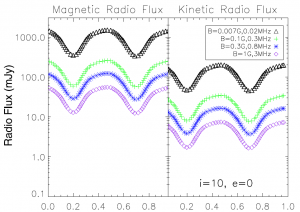Editor’s note: Astrobites is a graduate-student-run organization that digests astrophysical literature for undergraduate students. As part of the partnership between the AAS and astrobites, we occasionally repost astrobites content here at AAS Nova. We hope you enjoy this post from astrobites; the original can be viewed at astrobites.org!
Title: The Detectability of Radio Auroral Emission from Proxima b
Authors: Blakesley Burkhart & Abraham Loeb
First Author’s Institution: Harvard-Smithsonian Center for Astrophysics
Status: Published in ApJL, open access
Dazzling auroral displays are not uncommon in our solar system. In fact, when the Sun sends highly energetic particles out in to the solar system, any planets with a substantial magnetic field will interact with the particles, resulting in the emission of radio waves. Detecting this emission allows us to determine many interesting planetary properties, such as orbital parameters, habitability, plate tectonics and atmospheric compositions. Yet we have not observed any auroral activity from planets that lie outside our solar system (we have, however, detected radio auroral emission on a brown dwarf star!).

Figure 1: Artist’s impression showing Proxima b orbiting its red dwarf host Proxima Centauri. [ESO/M.Kornmesser]
What Are We Looking For?
To answer this question, the authors first employ radiometric Bode’s law to estimate the magnitude of radio waves released during stellar wind and magnetosphere interactions. Radiometric Bode’s law, derived from observations of magnetic planets within our own solar system, indicates that the brightness of radio waves increases with size of the planetary magnetosphere. Blackett’s law then suggests the size of the magnetosphere scales with mass and rotation speed, which translates to a predicted radio power of 1013 for Proxima b. When combined with Proxima b’s estimated magnetic field strengths of 0.007 – 1 G, comparable to the 0.5 G observed at the Earth’s equator, scientists expect the frequency of these radio waves to be between 0.02 – 2.8 MHz.

Figure 2: Predicted brightness of radio waves versus emission frequency, in accordance with Bode’s law, for 106 exoplanets. The expected values for Proxima b are highlighted in the blue square, with the yellow star representing a magnetic field value of 0.3 G. The black dashed line indicates the cut-off frequency for Jupiter. [Burkhart & Loeb 2017]
Modelling a Magnetosphere
So far, the authors have only estimated the brightness of auroral activity on Proxima b. With its close-in orbit creating a highly variable magnetosphere radius, we expect the variation in the observed radio waves to be rather large. To characterise this variability, authors implemented models of the wind and magnetic field around Proxima b as a function of various orbital parameters. An example of the results obtained from the simulations is shown below in Figure 3.

Figure 3: Variation in the observed radio brightness as the radius of the magnetosphere caries over Proxima b’s short 11.2 day orbit. Eccentricity = 0 and inclination = 10 degrees. [Burkhart & Loeb 2017]
From modelling the variability in radio flux for Proxima b, the authors concluded two things:
- Proxima b’s radio auroral emissions vary by almost an order of magnitude over one full orbit.
- The amplitude of the variation depends on orbital parameters — the eccentricity and inclination of the orbit — as well as on parameters of the stellar wind and planetary magnetic field.
Can We Detect Aurorae Around Proxima b?
There are a number of issues associated with undertaking observations of Proxima b’s radio emission. As previously mentioned, the ISM is highly problematic, as electrons within the ISM are more likely to absorb photons at low frequencies due to free-free absorption. Thankfully, this shouldn’t be an issue above 0.3 MHz for nearby planetary systems, like Proxima b, as there is less ISM to contend with. We also have to overcome the 10 MHz atmospheric cut-off introduced by absorption of photons in the ionosphere. Clearly the only solution here is to make observations from space. The authors mention several interesting proposals including a radio observatory on the Moon (one example given is ROLSS) and clusters of low-cost CubeSats to form a very large telescope (think of experiments like ALMA which combined lots of smaller telescopes to form one big one, but in space).

Figure 4: Example CubeSat with hands for scale. [NASA]
About the author, Amber Hornsby:
First year postgraduate researcher based in the Astronomy Instrumentation Group at Cardiff University. Currently I am working on detectors for future observations of the Cosmic Microwave Background. Other interests include coffee, Star Trek and pizza.

